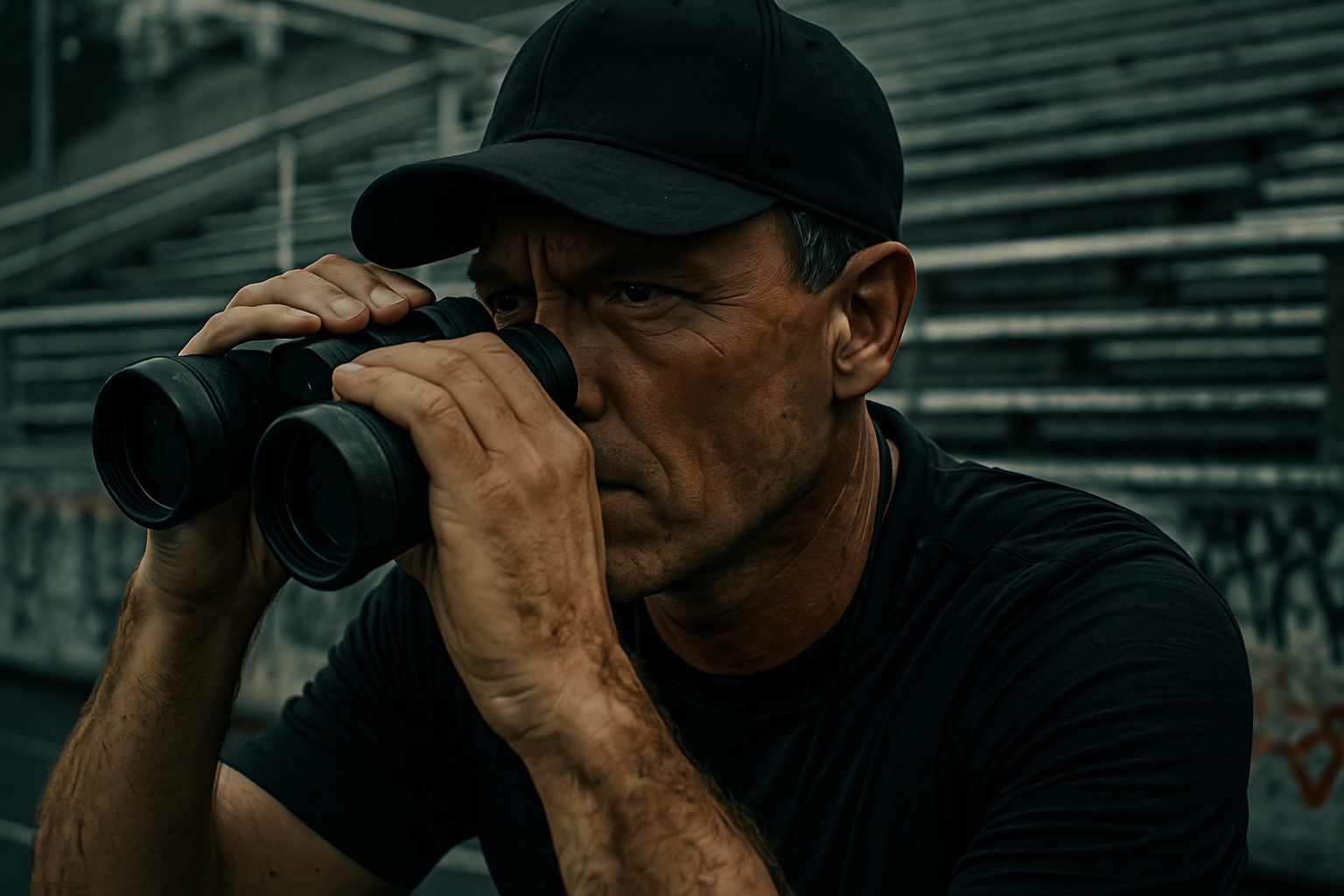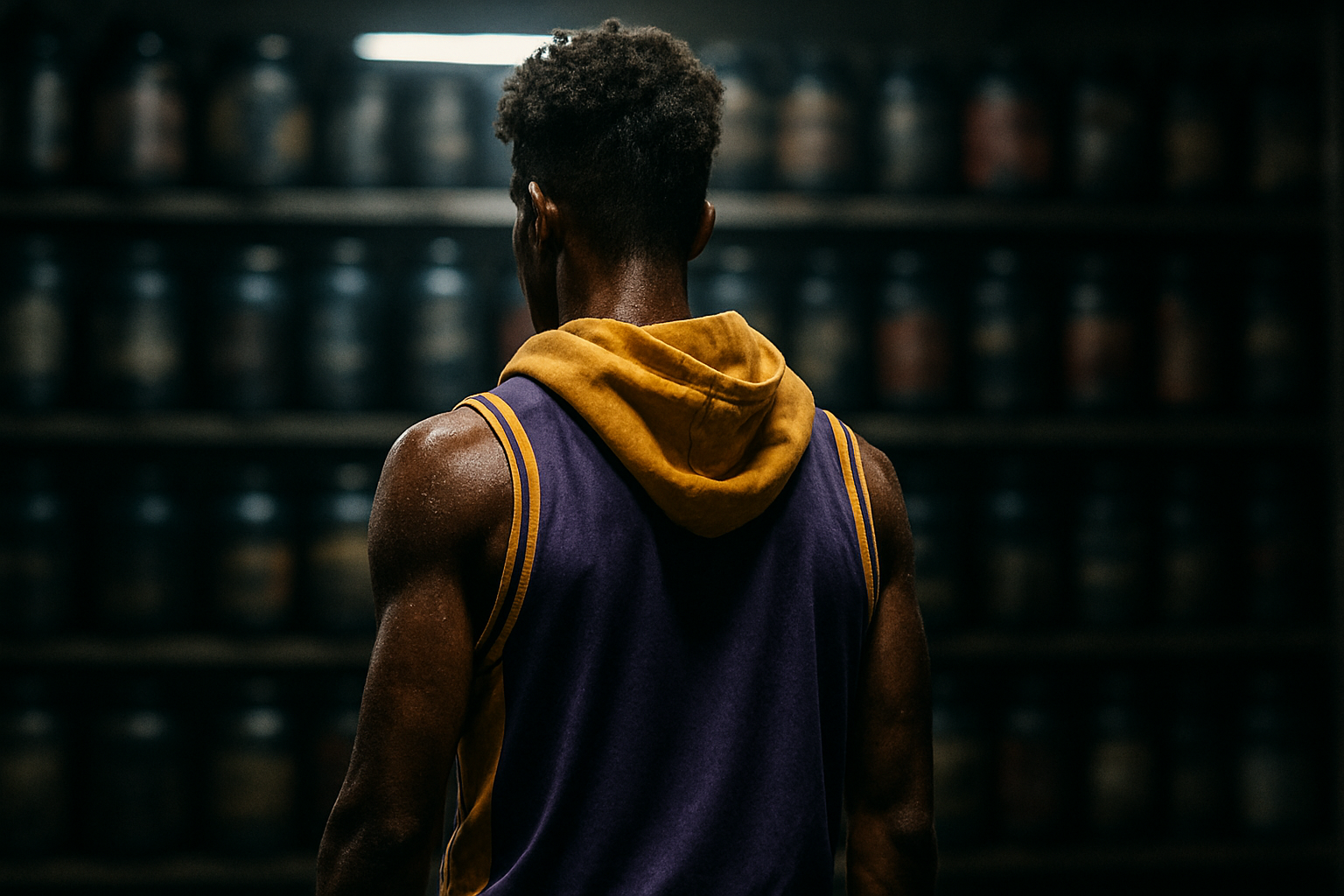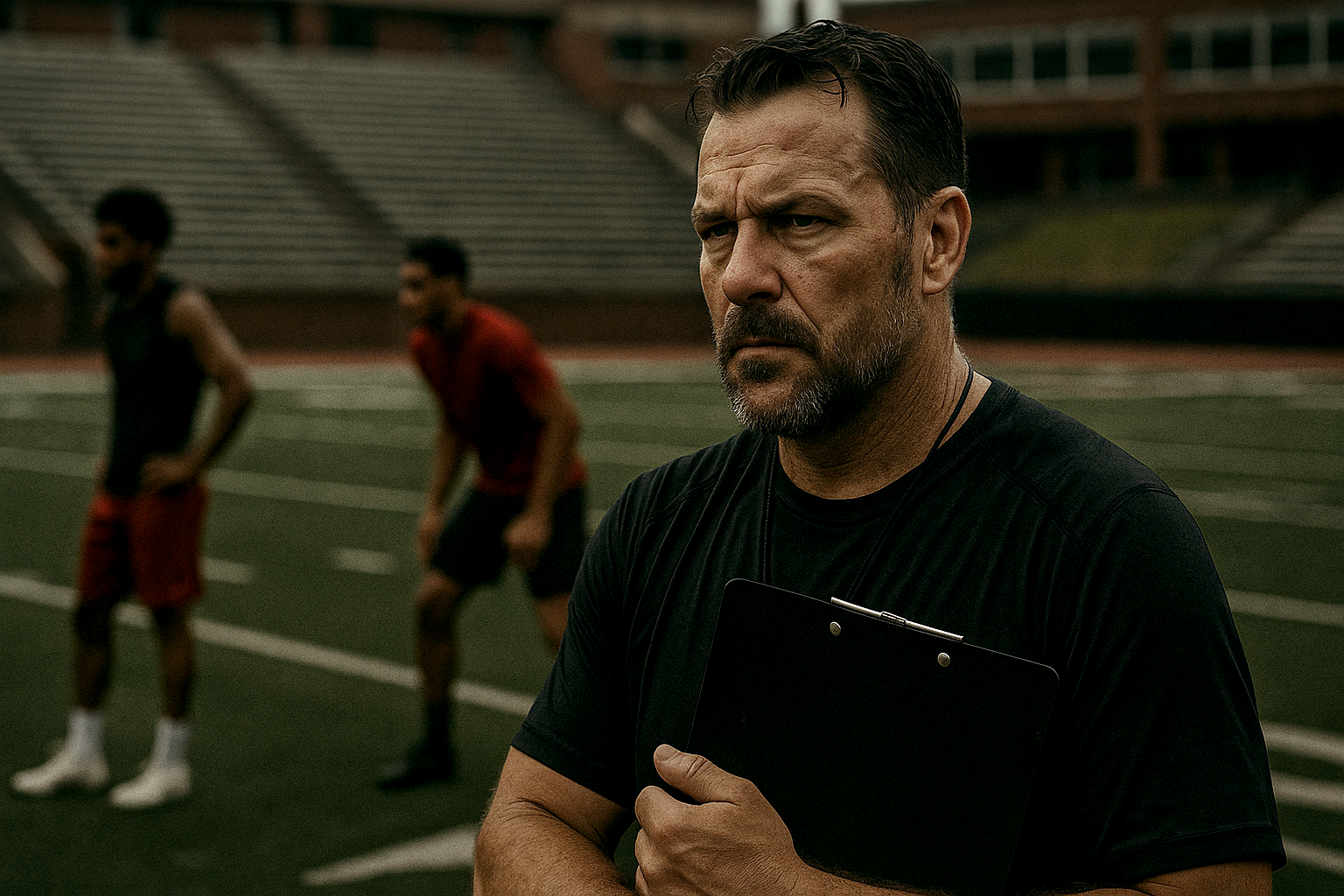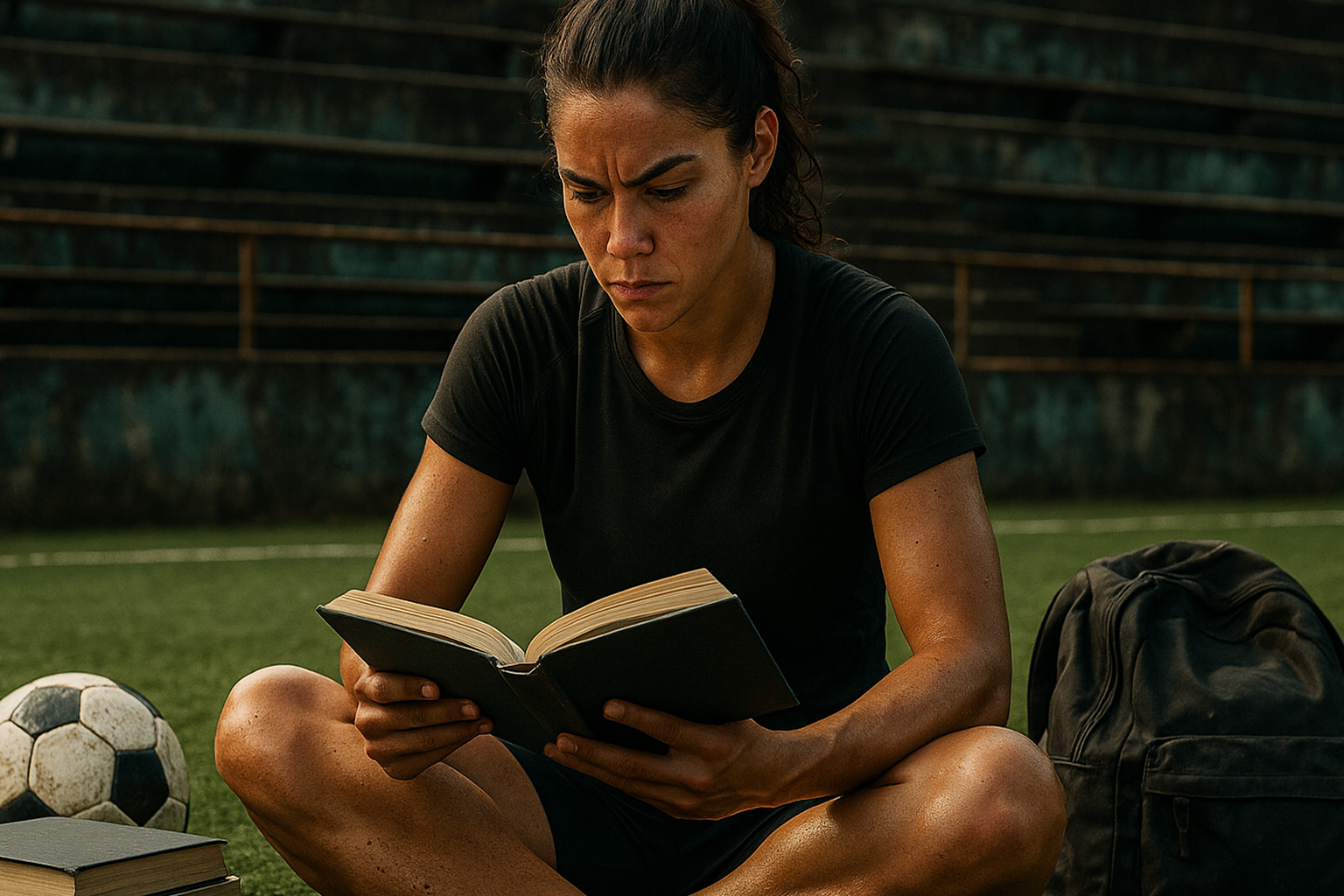With school wrapping up for the summer, now’s the perfect window for athletes to start thinking seriously about recruitment. But let’s be real – between the eligibility rules, endless options, and fear of making the “wrong” move, it can feel overwhelming fast. That’s why we broke it down. No fluff, just clear steps and honest insight to help you get moving in the right direction. Let’s go.
WHAT OPTIONS ARE THERE FOR ATHLETES LOOKING TO BE RECRUITED?
Athletes chasing the next level have more pathways than ever – but no two routes look the same. Whether your dream is lighting up the Olympic stage, dominating in college athletics, or signing a pro contract in a major league, the journey starts by understanding your options. From powerhouse organizations like the NCAA and NAIA to global platforms like the Olympics, and elite pro leagues like the NFL, NBA, MLB, NHL, WNBA, and MLS, each offers its own set of requirements, timelines, and recruitment processes.
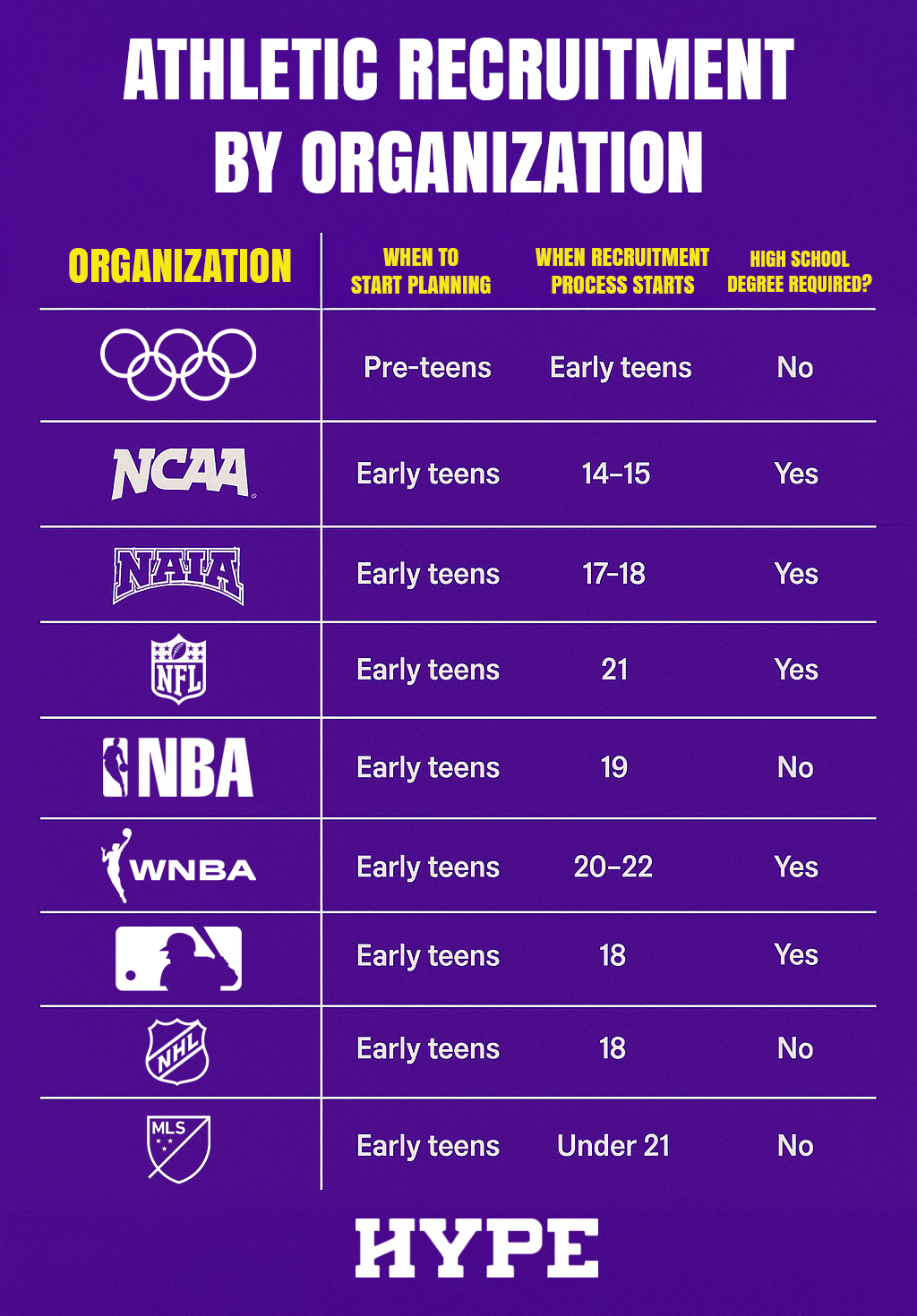
ATHLETIC ORGANIZATIONS & THEIR RECRUITMENT PROCESSES
What follows is a breakdown of some of the most prominent athlete recruitment pathways in North America – including the NCAA, NAIA, NFL, NBA, MLB, NHL, MLS, WNBA, and the Olympics. These aren’t the only options – far from it – but they’re among the most visible and competitive stages where talent meets opportunity. If you’re serious about going next-level, this is where your research begins.
THE OLYMPICS
The Olympics are the ultimate stage – the only truly global, multi-sport competition where more than 200 countries and thousands of athletes come together to chase greatness. With over 400 events spanning the Summer and Winter Games, it’s not just about medals – it’s about legacy, unity, and pushing human limits in front of the world.
Here is a look at Olympics eligibility requirements and recruitment processes, as sourced from their website.
WHAT ARE ELEGIBILITY REQUIREMENTS FOR AN ATHLETE TO GET RECRUITED TO THE OLYMPICS?
There’s no one-size-fits-all path to Olympic eligibility – it’s a layered process shaped by international rules, national guidelines, and sport-specific standards. Athletes have to follow the Olympic Charter, meet the criteria laid out by their sport’s International Federation (IF), and earn selection from their country’s National Olympic Committee (NOC). Your performance in qualifying events carries serious weight, and while there’s no blanket age requirement, some sports do have strict age rules.
If you’re aiming to get support resources as part of Team USA, the bar’s even higher – you’ll need to be nominated, compete in Olympic-level international events, and hold a world ranking that puts you near the top of your field.
Eligibility for the Olympics is based on several factors that vary by sport and country but generally include:
- Compliance with the Olympic Charter and the rules set by the sport's International Federation (IF).
- Selection by the National Olympic Committee (NOC) of the athlete’s country.
- Performance in qualifying competitions recognized by the IF and NOC.
- No universal age limit, but specific age rules may apply depending on the sport's governing federation.
For Team USA athletes, eligibility for support resources requires:
- Nomination to Team USA for the Olympics, Paralympics, Pan Am, or World Championships.
- Participation in Olympic-qualifying international competitions.
- A high world ranking in an Olympic sport, usually Top 20 and within the top 50% of competitors.
WHAT IS THE OLYMPICS RECRUITMENT PROCESS FOR ATHLETES?
Olympic recruitment doesn’t come with a clear map – there’s no central system, no standardized path. It’s a grind that depends entirely on your sport, your performance, and your place in the world rankings. Athletes have to rise through the ranks by competing in top-tier events sanctioned by their sport’s International Federation. Hit the right qualifiers, stay consistent, and climb the rankings – that’s how you get noticed. In the end, it’s your National Governing Body that puts your name forward, and your country’s Olympic Committee that decides if you make the cut. Every sport has its own playbook – and the margin for error is razor-thin.
The Olympics recruitment process includes the following:
- Train and compete at elite levels, typically through national and international events governed by their sport's IF.
- Qualify through competitions designated as Olympic qualifiers.
- Be selected or nominated by their sport’s National Governing Body (NGB) and approved by their National Olympic Committee (NOC).
- Maintain rankings or win spots through pathways defined in each sport’s Olympic Qualification Guide.
SO, HOW DO I GET RECRUITED TOTHE OLYMPICS AS AN ATHLETE?
Getting recruited to the Olympics isn’t a quick sprint – it’s a long-haul grind built on talent, discipline, and total commitment to your sport’s competitive system. It starts by choosing your sport and diving headfirst into its national and international circuits. From there, it’s all about showing up and standing out in high-stakes events – especially the ones that count as Olympic qualifiers. You’ll need to register with your sport’s National Governing Body (NGB), follow every step of the qualification process, and stay ranked among the best. At the end of the day, your shot at the Games depends on one thing: getting nominated by your NGB and signed off by your country’s National Olympic Committee (NOC). No shortcuts. Just work.
To get recruited to the Olympics as an athlete:
- Choose an Olympic sport and become deeply involved in its competitive scene.
- Compete at national and international levels, aiming for events that serve as Olympic qualifiers.
- Register with your sport’s NGB and ensure compliance with its qualification procedures.
- Achieve top results or rankings in competitions listed in the Olympic qualification pathways.
- Work with your NGB to be nominated to your country’s Olympic team through its NOC.
NCAA (NATIONAL COLLEGIATE ATHLETIC ASSOCIATION)
The NCAA – short for the National Collegiate Athletic Association – is the backbone of college sports in the U.S., supporting over 500,000 student-athletes across more than 1,000 schools and 20,000 teams. It runs championships in three divisions (I, II, and III) and sets the rules to keep competition fair, academics prioritized, and amateur status intact. At its core, the NCAA is about creating real opportunities – on the field, in the classroom, and beyond.
Here is a look at NCAA eligibility requirements and recruitment processes, as sourced by the NCAA’s Guide for the College-Bound Student-Athlete.
WHAT ARE THE ELIGIBILITY REQUIREMENTS FOR A STUDENT ATHLETE TO GET RECRUITED TO THE NCAA?
Before you can suit up in NCAA competition, you’ve got to clear some important eligibility hurdles – both in the classroom and on paper. Each division has its own playbook. For Divisions I and II, that means completing core courses, hitting a minimum GPA, and getting certified as an amateur through the NCAA Eligibility Center. Division III schools set their own standards, but international athletes still need to get cleared for amateur status through the NCAA Eligibility Center. Bottom line: knowing the rules early gives you the best shot at staying eligible – and staying in the game.
Division I:
- 16 NCAA-approved core courses (10 completed by start of senior year)
- Minimum 2.3 core GPA
- Amateur status certification
- Final transcript with graduation proof
Division II:
- 16 NCAA-approved core courses
- Minimum 2.2 core GPA
- Amateur status certification
Division III:
- No NCAA certifications; each school sets its own requirements
- International athletes must still be NCAA certified for amateur status
All prospective athletes must register with the NCAA Eligibility Center.
WHAT IS THE NCAA RECRUITMENT PROCESS FOR STUDENT ATHLETES?
The NCAA recruiting journey kicks off earlier than most realize – often as soon as ninth grade – and it’s a long game that requires more than just athletic skill. Staying on track means locking in academically, planning strategically, and reaching out early. From registering with the NCAA Eligibility Center and knocking out core courses to building relationships with coaches and taking campus visits, every step counts. Knowing the process – and the timing – can be the difference between getting on a coach’s radar or getting missed entirely.
Early Steps (Grades 9–10):
- Register with the NCAA Eligibility Center
- Take NCAA-approved core courses
- Build a strong academic record
Mid to Late High School (Grades 11–12):
- Share your NCAA ID with recruiting schools
- Update Eligibility Center with transcripts and sports participation
- Email coaches with highlight reels and personal details
- Take official or unofficial campus visits
- Request final amateurism certification (April 1 for fall, Oct. 1 for spring)
Coach-Athlete Interaction:
- Includes calls, messages, emails, social media, campus visits, and National Letter of Intent (NLI) offers
- Subject to recruiting calendars (especially in Divisions I and II)
SO, HOW DO I GET RECRUITED TO THE NCAA AS A STUDENT ATHLETE?
Getting recruited to the NCAA isn’t luck – it’s work. It starts early, usually around ninth grade, and it takes consistent effort on both sides of the student-athlete identity. You’ve got to register with the NCAA Eligibility Center, stay sharp academically, and keep leveling up on the field. But talent alone won’t get it done. The athletes who stand out are the ones who stay visible, build real connections with programs, and stay organized every step of the way. Recruitment rewards the ones who are ready – not just athletically, but strategically.
Start Early:
- Register with the NCAA Eligibility Center by 9th grade
- Learn and follow core course requirements
Get Noticed:
- Excel academically and athletically
- Play on competitive teams, attend camps/showcases
- Create highlight videos and proactively contact coaches
Stay Engaged:
- Monitor tasks in your Eligibility Center account
- Visit campuses (official/unofficial)
- Keep a positive online and offline presence
Be Strategic:
- Know recruiting timelines
- Research schools and their requirements
- Ask questions about scholarships, play time, academics, and coach styles
NAIA (NATIONAL ASSOCIATION OF INTERCOLLEGIATE ATHLETICS)
The NAIA – short for the National Association of Intercollegiate Athletics – runs the show for smaller college sports programs across the U.S., with a focus on character, competition, and community. It supports more than 83,000 student athletes each year, offering over $1.3 billion in scholarships and hosting 28 national championships across men’s and women’s sports. At its core, the NAIA is all about balancing athletic performance with academic growth – and keeping the student athlete front and center.
Here is a look at NAIA eligibility requirements and recruitment processes, as sourced from NAIA’s Guide for the College-Bound Athlete.
WHAT ARE THE ELIGIBILITY REQUIREMENTS FOR A STUDENT ATHLETE TO GET RECRUITED TO THE NAIA?
NAIA eligibility isn’t one-size-fits-all – but every path starts with meeting some core academic standards. For most incoming freshmen, that means graduating from an accredited high school and checking off at least two of three boxes: a minimum ACT or SAT score, a 2.0 GPA, or ranking in the top half of your class. There are also options for international students, homeschool or GED grads, and college transfers – each with its own rules and paperwork. The key is knowing your path early so you can stay eligible and keep your recruitment goals in play.
To be eligible for NAIA recruitment as a freshman, student athletes must:
- Graduate from an accredited high school.
- Meet two of the following three criteria:
- Minimum ACT score of 18 or SAT score of 970
- High school GPA of 2.0 (on a 4.0 scale)
- Graduate in the top half of their high school class
Other paths to eligibility exist for:
- International students (must provide translated records and meet similar academic/test score standards),
- GED and homeschool students (must meet test score requirements or petition for waivers),
- Transfers (must meet credit hour and academic progress benchmarks based on semesters completed and seasons of competition used)
WHAT IS THE NAIA RECRUITEMENT PROCESS FOR STUDENT ATHLETES?
The NAIA keeps things flexible – there’s no required Letter of Intent, though some schools or conferences might use their own versions with specific expectations. To get started, athletes need to register at PlayNAIA.org, submit their transcripts and test scores, and get an official eligibility determination. One major plus: coach communication is wide open. Unlike other leagues, NAIA coaches can reach out directly with minimal restrictions, and athletes are allowed up to two tryout days during their recruitment journey.
To begin the recruitment process for NAIA, student athletes must:
- Register with the NAIA Eligibility Center at PlayNAIA.org
- Submit transcripts and test scores
- Receive an eligibility determination
SO, HOW DO I GET RECRUITED BY THE NAIA AS A STUDENT ATHLETE?
Getting recruited to the NAIA is all about taking the lead. With open communication allowed between athletes and coaches, it’s on you to make the first move. That means registering at PlayNAIA.org, sending in your transcripts and test scores (use code 9876), and building a solid academic and athletic profile. From there, it’s about reaching out directly to coaches, staying eligible, and knowing the rules around amateur status and competition limits. The more proactive and prepared you are, the better your shot at locking in a spot on an NAIA roster.
To get recruited by the NAIA as a student athlete:
- Register at PlayNAIA.org to create an eligibility profile and submit required documents (transcripts, test scores).
- Send test scores directly to the NAIA (code 9876).
- Connect with coaches early – since the NAIA allows open communication, reach out directly to coaches at schools you’re interested in.
- Stay academically eligible: Keep your GPA up, meet test score benchmarks, and enroll full-time (at least 12 credit hours per term).
- Research schools and sports using NAIA’s school and sport search tools.
- Prepare for competition: NAIA athletes must maintain amateur status and compete within four seasons over 10 semesters.
NFL (NATIONAL FOOTBALL LEAGUE)
The NFL – the National Football League – is the top tier of professional American football, made up of 32 teams split between the AFC and NFC. Each year, the league runs through a preseason, a 17-game regular season, and playoffs that culminate in the Super Bowl – one of the biggest sporting events on the planet. It’s the pinnacle of the sport, with its headquarters based in Midtown Manhattan.
Here is a look at NFL eligibility requirements and recruitment processes, as sourced from the NFL’s operations website.
WHAT ARE THE ELIGIBILITY REQUIREMENTS FOR AN ATHLETE TO GET RECRUITED TO THE NFL?
Before you can make a run at the NFL, you’ve got to meet the league’s eligibility standards – no exceptions. These rules are in place to make sure prospects are ready for the physical, mental, and competitive demands of pro football. Whether you’re declaring early or entering after using up your college eligibility, every athlete has to follow a strict set of guidelines and get verified through official league channels. Here’s what it takes to get draft-eligible.
To be eligible for the NFL Draft, an athlete must:
- Be at least three years out of high school.
- Have used up their college eligibility, or request early entry if they’ve graduated early or are underclassmen.
- Submit applications by seven days after the NCAA National Championship Game if entering early.
- Be verified by NFL Player Personnel staff through academic records and all-star game participation
WHAT IS THE NFL RECRUITMENT PROCESS FOR ATHLETES?
The NFL recruiting journey isn’t just about raw talent – it’s a multi-stage process built to find the total package. From high school through college, players are evaluated on everything from athleticism to leadership, character, and long-term potential. Scouts track performance, conduct interviews, and run workouts to see who’s truly ready for the leap. It’s a grind, but every step is a chance to prove you belong at the next level. Here’s how it all plays out.
The NFL player recruitment process includes:
- Scouting: Scouts track players from high school through college, using both data and subjective assessments (like leadership and work ethic).
- College Advisory Committee evaluations: Help underclassmen decide whether to declare for the draft.
- Pro Days & private workouts: Scouts evaluate players on college campuses.
- NFL Scouting Combine: Around 335 players participate in a four-day evaluation that includes physical tests, interviews, and medical checks.
- NFL Draft: A seven-round selection process where teams choose players. Undrafted players may still try out or join practice squads
SO, HOW DO I GET RECRUITED TO THE NFL AS AN ATHLETE?
Making it to the NFL takes more than talent – it takes grit, strategy, and years of locked-in effort. The competition is brutal, and the odds are steep, but players who know the path, stay disciplined, and make smart moves along the way can put themselves in position to break through. If the league is your goal, here’s what it takes to give yourself a real shot.
To improve your chances of getting recruited to the NFL as an athlete:
- Play college football at a high level, preferably NCAA Division I.
- Develop over 3+ years, showcasing your skills and staying academically eligible.
- Perform well during Pro Days and (if invited) at the NFL Combine.
- Engage with scouts and college advisors to understand where you stand.
- Stay in college if needed – declaring early without being draft-ready can end your eligibility and reduce your chances.
- If undrafted, attend rookie camps, pursue tryouts, or join development leagues to remain visible to teams
NBA (NATIONAL BASKETBALL ASSOCIATION)
The NBA – the National Basketball Association – is the pinnacle of men’s basketball worldwide, home to 30 teams across North America and packed with elite talent from around the globe. Split into Eastern and Western Conferences, each with three divisions, the NBA sets the standard for professional hoops – where the best of the best go to compete, inspire, and make history.
Here is a look at NBA eligibility requirements and recruitment processes, as sourced from the NBA’s website and collective bargaining agreement.
WHAT ARE THE ELIGIBILITY REQUIREMENTS FOR AN ATHLETE TO GET RECRUITED TO THE NBA?
To enter the NBA Draft, players have to check a few key boxes – it’s about proving you’re ready, not just talented. You need to be at least 19 years old during the draft year and one full season removed from high school. From there, eligibility can come through different paths: finishing four years of college, playing pro overseas, or declaring as an early entry candidate. International players have their own routes too, like automatic eligibility at 22 or experience with a pro team outside the U.S. Bottom line: the system’s built to make sure athletes bring both game and maturity to the league.
To be eligible for the NBA Draft, an athlete must meet the following conditions:
- Be at least 19 years old in the calendar year of the draft.
- Be one NBA season removed from high school graduation (or the graduation of their class, if they did not graduate).
- Satisfy one or more of these conditions:
- Completed four years of college or is graduating that year with no NCAA eligibility left.
- Graduated high school and did not enroll in college, with four years elapsed since graduation.
- Signed and played for a professional team outside the NBA before January 1 of the draft year.
- Submitted an Early Entry declaration at least 60 days prior to the draft.
- Be an international player who is:
- 22 years old or older in the draft year,
- or has played professionally outside the U.S. before the draft,
- or has submitted an Early Entry declaration.
WHAT IS THE NBA RECRUITMENT PROCESS FOR ATHLETES?
The NBA recruitment process is a carefully built pipeline designed to spot and elevate the best basketball talent on the planet. It starts with deep scouting – across high school gyms, college arenas, and international courts, including programs like the NBA Academy. Top prospects may earn an invite to the NBA Draft Combine, where they’re put through the wringer with drills, interviews, and evaluations. Draft order gets set through the NBA Lottery, leading into the two-round NBA Draft where teams select eligible players and secure exclusive rights to negotiate contracts. Get picked, and you’re officially in the conversation – your NBA journey begins.
The NBA recruitment process includes:
- Scouting: Players are evaluated during high school, college, international play, and programs like NBA Academy.
- NBA Draft Combine: A key pre-draft event where prospects perform drills, measurements, and interviews.
- NBA Draft Lottery: Determines draft order for teams that didn’t make the playoffs.
- NBA Draft: Two rounds where teams select eligible players. Each team typically has one pick per round.
- Draft Rights & Contracts: Teams hold exclusive negotiating rights with drafted players. If no contract is signed within a year, rights may be lost or transferred.
- NBA Academy (optional path): For international high school prospects seeking structured development with potential draft preparation.
SO, HOW DO I GET RECRUITED TO THE NBA AS AN ATHLETE?
If the NBA is your goal, raw talent won’t cut it – you need a blueprint. Getting recruited starts with making noise in elite competition and building your name early. Whether it’s dominating at a top prep school, playing overseas, or joining development programs like the NBA Academy or Basketball Without Borders, every step matters. You’ll also need to make smart moves: declare for the draft at the right time, prep for the NBA Combine, and show scouts and agents that you’ve got more than just skill – you’ve got consistency, professionalism, and drive.
To increase your chances of being recruited to the NBA as an athlete:
- Excel in high-level competition (e.g., NCAA Division I, international pro leagues, or elite prep programs).
- Get noticed early through strong performance, character, and development–often starting in high school or earlier.
- Attend he NBA Academy (if eligible internationally) or participate in programs like Basketball Without Borders.
- Declare for the Draft (as an early entry candidate if applicable).
- Prepare for the NBA Draft Combine, which significantly influences draft position.
- Build visibility with scouts, agents, and through strong team and tournament performances.
Ultimately, consistent elite performance and strategic visibility are key.
WNBA (WOMEN'S NATIONAL BASKETBALL ASSOCIATION)
The WNBA – the Women’s National Basketball Association – is home to the best women’s basketball talent in the world. Launched in 1996 and tipping off its first season in 1997, it holds the title as the longest-running women’s pro sports league in North America. With 12 teams divided between the Eastern and Western Conferences, the WNBA runs from May through October, packing a 40-game season with elite competition, high stakes, and serious skill.
Here is a look at WNBA eligibility requirements and recruitment processes, as sourced from the WNBA’s website and 2x Inc.
WHAT ARE THE ELIGIBILITY REQUIREMENTS FOR AN ATHLETE TO GET RECRUITED TO THE WNBA?
Getting into the WNBA Draft starts with meeting specific eligibility rules – and they’re different depending on whether you’re a domestic or international basketball player. These guidelines are designed to make sure athletes are physically, mentally, and professionally ready for the league’s demands. If you’re serious about making it, the first step is knowing exactly where you stand when it comes to age and eligibility.
Eligibility for the WNBA is different between domestic and international athletes:
- For U.S. Players:
- Must be at least 22 years old by December 31 of the draft year.
- Must meet one of the following:
- Completed college eligibility,
- Graduated from a four-year college,
- Be four years removed from high school graduation.
- Players scheduled to graduate within 3 months after the draft are considered “graduates” for draft purposes.
- Must renounce any remaining NCAA eligibility to enter the draft.
- For International Players:
- Must be at least 20 years old by December 31 of the draft year.
- Defined as:
- Born and residing outside the U.S.,
- Has never played college basketball in the U.S.
- May have U.S. citizenship or parentage but still count as international if they never enrolled in a U.S. college.
WHAT ISTHE WNBA RECRUITMENT PROCESS FOR ATHLETES?
The WNBA recruitment process is built to find and elevate the top hoopers on the planet – but the draft is only part of the puzzle. Scouting happens year-round, and coaches, agents, and exposure events all play key roles in getting talent on the radar. Even if you go undrafted, training camps and showcases offer legit paths to prove yourself. If you’re chasing a WNBA roster spot, understanding how the whole system works is non-negotiable – every step is a shot to stand out.
Recruitment for the WNBA revolves around the following:
- Scouting: Conducted extensively throughout the year by WNBA staff.
- WNBA Draft: Held annually, usually in April.
- Coaches & Agents: Coaches play a vital role in getting athletes noticed; agents help manage exposure and opportunities.
- Training Camps: Undrafted players may join teams via free agency and must earn a roster spot through performance during camp.
- Free Agent Lists & Exposure Camps: Players can attend tryout or assessment camps (some credible, some not) to get noticed.
SO, HOW DO I GET RECRUITED TO THE WNBA AS AN ATHLETE?
Breaking into the WNBA takes more than game – it takes strategy, visibility, and the right people in your corner. Whether you’re dominating in college, making waves overseas, or grinding as an undrafted hopeful, there are multiple ways to earn a roster spot. From working with well-connected coaches and agents to hitting legit exposure camps and navigating the free agency grind, every move you make matters. If you want to get noticed, you’ve got to play smart – not just hard.
There are a few key things to getting recruited to a WNBA team:
- College Path: Play college basketball, perform well, and become draft-eligible by age and eligibility standards.
- Have a Strong Coach or Agent: A coach with good contacts can help get you noticed by WNBA scouts. An agent can submit your name to free agent lists, get you into training camps, and distribute your game film.
- Attend Credible Exposure Camps: Research credible exposure camps and attend one. A good agent can help with this.
- International Players: Need a well-connected agent and may require game footage or to be seen live by scouts during international play.
- Free Agency: If undrafted, aim to secure a training camp invite and perform well enough to earn a roster spot.
MLB (MAJOR LEAGUE BASEBALL)
The MLB – Major League Baseball – is the oldest and most iconic pro sports league in North America, featuring 30 teams across the U.S. and Canada. It’s the top level of baseball, where tradition meets talent on a gigantic stage. With roots deep in American culture and eyes set on international growth, MLB blends competitive fire with community, innovation, and worldwide reach – making it more than a game. It’s a legacy.
Here is a look at MLB eligibility requirements and recruitment processes, as sourced from the MLB website.
WHAT ARE THE ELIGIBILITY REQUIREMENTS FOR AN ATHLETE TO GET RECRUITED TO THE MLB?
Before a player can hear their name called in the MLB Rule 4 Draft (aka the MLB Draft, First-Year Player Draft, or Amateur Draft), they’ve got to check a few key eligibility boxes. The league sets clear rules around age, education, and residency to determine who’s ready – and allowed – to enter the draft. Here’s what it takes to get draft-eligible.
Athletes are eligible for the MLB Draft (aka Rule 4 Draft) if they meet the following criteria:
- Must reside in the U.S., U.S. territories (like Puerto Rico), or Canada.
- Must fit into one of these groups:
- High school graduates who haven't enrolled in college.
- Junior college players (after at least one year).
- Four-year college players after their junior year or if they are at least 21 years old.
WHAT IS THE MLB RECRUITMENT PROCESS FOR ATHLETES?
There’s no single path to getting recruited by Major League Baseball – and that’s by design. MLB offers a range of routes to help identify and develop talent at every stage. Whether it’s through the formal draft, elite scouting programs, or developmental leagues, each pathway gives players a shot to get noticed and prove they belong on the pro stage. Here’s how the recruitment process breaks down.
The MLB recruitment process includes several pathways for athletes:
- Rule 4 Draft (First-Year Player Draft): Held annually between June 1 and July 20. Players are selected by MLB teams and offered signing bonuses based on assigned slot values.
- Draft Lottery: Determines the first six picks based on a weighted lottery system involving non-postseason teams.
- Rule 5 Draft: Allows teams to select certain players not on other teams' 40-man rosters under specific conditions.
- Prospect Development Pipeline (PDP): A free, invite-only program that identifies top high school talent and evaluates them for draft consideration.
- MLB Draft League: A six-team league offering draft-eligible and post-eligibility players a platform to showcase talent directly in front of scouts using advanced analytics and former Minor League facilities.
SO, HOW DO I GET RECRUITED TO THE MLB AS AN ATHLETE?
If you’re aiming for the big leagues, talent’s only part of the equation – strategy is just as crucial. Getting noticed by MLB scouts and decision-makers means knowing where to play, how to stand out, and who to build relationships with. Programs like the Prospect Development Pipeline and the MLB Draft League are built to spotlight serious talent. If you want to stand out, you’ve got to be intentional with every move. Here’s how to raise your odds of getting recruited.
To boost your chances of getting recruited to the MLB Draft:
- Participate in the Prospect Development Pipeline (PDP): Gain early exposure to MLB scouts. Selection is by invite only via USA Baseball.
- Play in the MLB Draft League: Compete in the pre-draft (amateur) and post-draft (professional) portions of the league. Scouts from all 30 MLB teams observe these games.
- Perform well in high school, college, or junior college baseball: Scouts track performance heavily across these levels.
- Get scouted and recommended: Prep Baseball Report (PBR) helps identify and recruit top prospects for the MLB Draft League. Coaches and scouts are involved in nominating players.
- Maintain amateur status and follow pitch count guidelines: Particularly for pitchers, following health/safety best practices (like MLB’s Pitch Smart guidelines) can make a difference.
NHL (NATIONAL HOCKEY LEAGUE)
The NHL – National Hockey League – has been the top tier of professional ice hockey since 1917, featuring 32 teams across the U.S. and Canada. It’s a global game, with players from more than 20 countries and fans tuning in from over 260. At its heart is the Stanley Cup – one of the most iconic trophies in all of sports. Beyond the rink, the NHL connects with hundreds of millions through live games, streaming, and community-driven programs like NHL Unites and NHL STREET, pushing the sport forward while staying rooted in tradition.
Here is a look at NHL eligibility requirements and recruitment processes, as sourced from the NHL website and collective bargaining agreement.
WHAT ARE THE ELIGIBILITY REQUIREMENTS FOR AN ATHLETE TO GET RECRUITED TO THE NHL?
To be eligible for the NHL Entry Draft, players have to meet a specific set of age and participation rules – all designed to keep the playing field fair and consistent. You need to be at least 18 by September 15 of the draft year, and no older than 20 by December 31 – unless you’re a European player, who might qualify under different rules. If you’ve already been drafted twice or are on another team’s Reserve List (outside of a tryout), you’re out. And if you’re 21 or older and already played in North America between ages 18 and 20, you’re also ineligible. Knowing where you stand is key if you’re serious about chasing an NHL career.
To be eligible for the NHL Entry Draft, an athlete must:
- Turn 18 years old by September 15 of the draft year.
- Not be older than 20 years old by December 31 of the draft year (unless they are playing in Europe and meet separate eligibility criteria).
- Not have been previously drafted twice.
- Not already be on another team’s Reserve List (except as a tryout).
- Players who are 21 or older and have played at least one season in North America between the ages of 18 and 20 are also not eligible.
WHAT IS THE NHL RECRUITMENT PROCESS FOR ATHLETES?
The NHL recruitment process is a multi-step grind built to find and shape the best hockey talent on the planet. It starts with early scouting in junior leagues, college hockey, and international play – all leading up to the NHL Entry Draft, where top prospects are selected. If you’re drafted, you’ll likely sign an entry-level contract and sharpen your game in the minors before cracking an NHL roster. Didn’t get drafted or aged out? Free agency’s still on the table – another shot to break into the league if you’re ready to prove you belong.
The NHL recruitment process includes:
- Scouting: Scouts evaluate players across junior leagues, college, international play, and other leagues.
- Entry Draft: Eligible players are selected annually. Draft order is determined by team performance, with the lowest-performing teams choosing first.
- Entry-Level Contracts (ELCs): Drafted players sign standard contracts with set terms and salary caps based on their age.
- Development: Players often spend time in minor leagues (AHL or ECHL) before joining an NHL roster.
- Free Agency: Older or undrafted players may sign as unrestricted or restricted free agents depending on their experience level and prior team relationships.
SO, HOW DO I GET RECRUITED TO THE NHL AS AN ATHLETE?
Making it to the NHL isn’t just about skill – it’s about playing the long game with strategy, consistency, and serious prep. You’ve got to start early, compete at the highest levels, and make sure you’re showing up where scouts are watching. Whether it’s getting exposure in junior leagues or international showcases, hitting the NHL draft eligibility marks, or earning that entry-level contract, every move counts. If you want a real shot at the pros, you’ve got to be intentional from day one. Here’s how to put yourself in the best position to get noticed.
To improve your chances of being recruited to the NHL as an athlete:
- Develop early through high-level competition such as junior leagues (e.g., CHL), NCAA hockey, or European professional leagues.
- Gain exposure through showcases, tournaments, and consistent performance.
- Get scouted: NHL scouts monitor many leagues; being in a reputable league increases visibility.
- Be draft eligible: Understand and meet the age and participation criteria for the NHL Entry Draft.
- Sign an ELC: After being drafted or scouted, sign an entry-level contract and work through affiliate teams if needed.
- Maintain performance and eligibility: On-ice performance, physical fitness, and off-ice conduct all impact your progression.
MLS (MAJOR LEAGUE SOCCER)
MLS – or Major League Soccer – is the top-tier pro soccer league in the U.S. and Canada. Launched in 1996 after the momentum of the 1994 FIFA World Cup, the league has grown steadily and now features 30 clubs competing at the highest level of North American soccer.
Here is a look at MLS eligibility requirements and recruitment processes, as sourced from the MLS website.
WHAT ARE THE ELIGIBILITY REQUIREMENTS FO AN ATHLETE TO GET RECRUITED TO MLS?
Getting into Major League Soccer (MLS) isn’t a one-path-fits-all deal – eligibility depends on your age, nationality, and how you’ve developed as a player. Whether you’re coming up through an MLS academy, making noise in college soccer, or qualifying as a domestic player, there are several ways to break into the league. Knowing how rules like the Homegrown Player Rule, the U22 Initiative, and the MLS SuperDraft apply to your situation is key to finding your best route to the pros. Here’s what you need to know.
There are multiple eligibility pathways to MLS depending on an athlete's age, nationality, and development route:
- Domestic Player Status:
- U.S. citizen, green card holder, refugee/asylee, or Homegrown International Rule qualifier for U.S.-based clubs.
- Canadian citizen or equivalent statuses for Canadian-based clubs.
- Homegrown Player Rule: Must have joined an MLS academy or a Canadian Approved Youth Club before turning 15 and sign first pro contract with MLS or its affiliate. Homegrown Players must be 21 or younger.
- U22 Initiative: Players aged 22 or younger when first eligible to play; must meet contract and salary guidelines.
- SuperDraft: Players must be at least collegiate sophomores, Generation adidas signees, or meet other eligibility as determined by MLS.
WHAT IS THE MLS RECRUITMENT PROCESS FOR ATHLETES?
Major League Soccer (MLS) opens the door through multiple entry points, each shaped around where you are in your development. Whether you’re growing through an MLS academy, turning heads in college, or grinding as a free agent, there’s a pathway built for your stage. Teams use a mix of structured systems and flexible strategies to build their rosters – and knowing how those recruitment routes work is essential if you want to break into the league.
MLS recruits players using a variety of mechanisms:
- Homegrown Signings: For academy-developed players who meet specific criteria.
- MLS SuperDraft: College players and Generation adidas signings enter the league through this annual draft.
- Discovery Process: Clubs scout and claim rights to players not under MLS contract or assigned by other mechanisms.
- Trades: Players, allocation money, and other assets can be traded.
- Affiliate Short-Term Agreements: Young players (age ≤25) from MLS NEXT Pro affiliates can be signed short-term.
- Waivers, Re-Entry, Free Agency: For current/former MLS players not under contract.
SO, HOW DO I GET RECRUITED TO MLS AS AN ATHLETE?
If MLS is where you’re headed, the earlier you understand the recruitment game, the better your chances. Whether you’re developing in an MLS Academy, turning heads in college, or standing out on a youth national team, there’s more than one way to get there. From Homegrown Player deals to the MLS SuperDraft and Generation adidas contracts, your shot at the league comes down to timing, talent, and smart moves. Here’s how to get on the radar – and stay there.
To improve your chances of getting recruited to an MLS team:
- Join an MLS Academy early (before age 15) and aim for a Homegrown Player contract.
- Play College Soccer and declare for the MLS SuperDraft, ideally by your sophomore or junior year.
- Stand Out in Youth National Teams or PDPs to be considered for Generation adidas.
- Maintain eligibility by ensuring you meet domestic/international rules and roster slot criteria.
- Attend trials or exposure events, and consider playing in MLS NEXT Pro, college, or other professional leagues to get scouted.
- Work with reputable agents who understand MLS pathways and can advocate for your placement.
WHAT DO RECRUITERS AND COACHES LOOK FOR IN ATHLETES?
When it comes to getting recruited, skill might get you noticed – but character is what seals the deal. Former college soccer coach Molly Grisham and former pro tennis player Marianne Werdel both pull back the curtain on what coaches are really looking for: athletes who lead with integrity, show up with resilience, and bring more than just stats to the table. From body language on the bench to how you handle failure, every moment tells a story – and coaches are paying attention. Talent opens the door, but who you are as a teammate, student, and person is what determines whether you stay in the room.
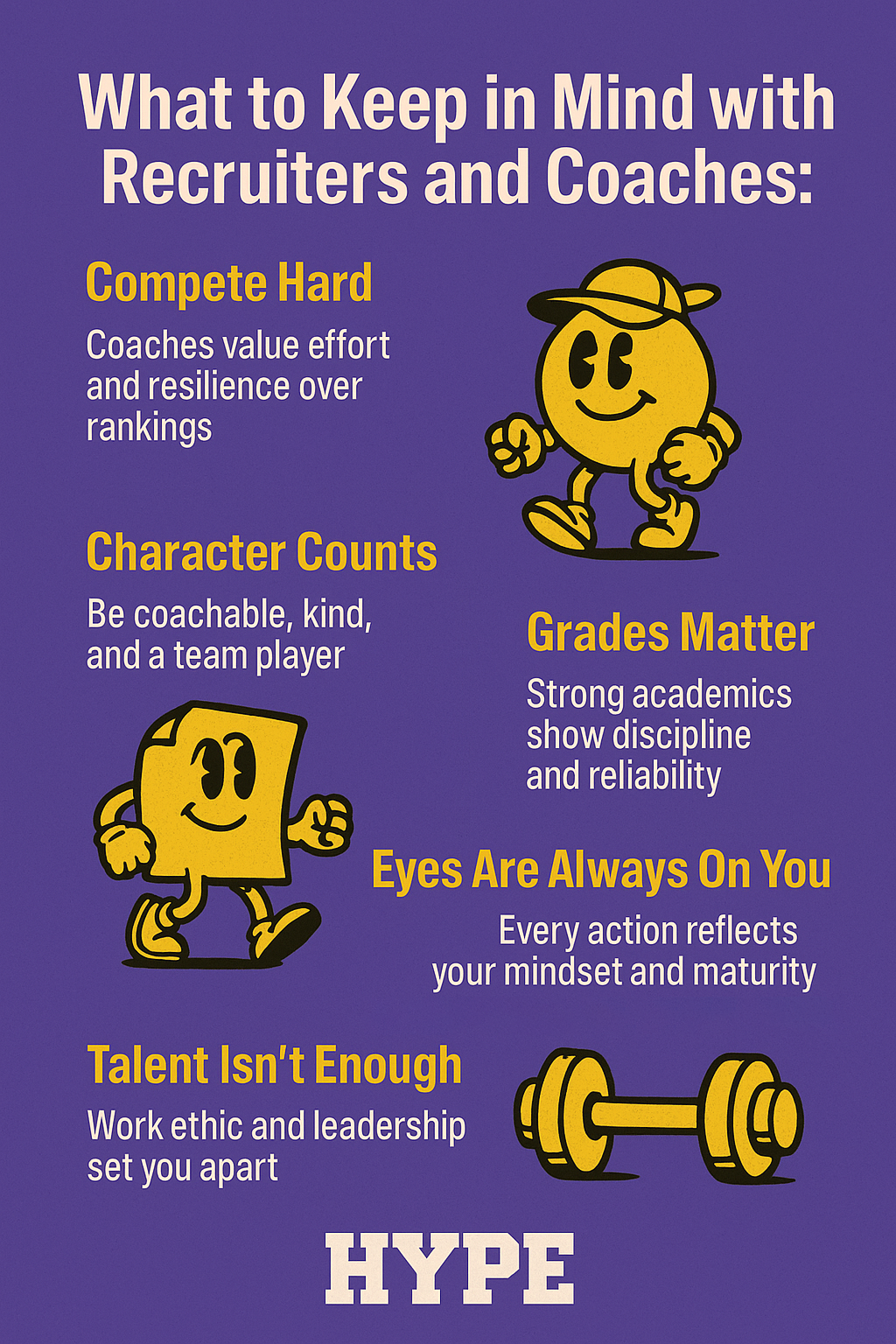
COACHES WANT THE WHOLE PACKAGE – NOT JUST HIGHLIGHTS
Former college soccer coach Molly Grisham cuts to the chase in an interview with Renee Lopez: when it comes to recruiting, coaches aren’t just scanning stats – they’re looking for the kind of athlete who brings more than talent to the table.
Here are 8 things coaches and recruiters are looking for in athletes:
- Talent alone isn’t enough: Coaches look for more than skill – they want athletes who bring character, leadership, and resilience to the team.
- Be a great teammate: How you treat others on and off the field matters. Poor body language or selfish behavior can get you crossed off a coach’s list – fast.
- Attitude is evaluated: Coaches are watching how you respond to setbacks. Do you lead with composure, or spiral when things don’t go your way?
- Your character is public: Coaches will check your social media. If it reflects poor judgment or negativity, they’ll move on – no matter your talent.
- Academics count too: A strong GPA and test scores show responsibility and discipline – two traits every coach values.
- Fit goes both ways: Coaches want players who align with their team culture, not just their playing style.
- Being a good person is a choice: Unlike talent or academics, being respectful, coachable, and kind is 100% within your control – and it’s non-negotiable.
- You’re always being evaluated: Every game, practice, and interaction is part of your tryout – treat them like it.
MORE THAN A MATCH SCORE – WHAT COACHES REALLY NOTICE
Marianne Werdel – former pro tennis player turned coach – drives home many of the same truths in her own advice to athletes: talent matters, but mindset, grit, and self-awareness matter more.
Here are 9 things to keep in mind for getting recruited by coaches and recruiters:
- Compete – don’t hide: Coaches want athletes who embrace competition, not those who avoid it to protect rankings or ratings.
- UTR is just a tool: Your rating helps coaches gauge your level, but it’s just one piece of the puzzle – how you compete matters far more.
- Coaches watch everything: Retiring from matches, defaulting, or playing “safe” sends the wrong message – effort and resilience matter.
- Don’t coast after committing: Signing a letter of intent isn’t the finish line – coaches expect you to keep training and show up prepared.
- Strong academics matter: A solid GPA tells coaches you’re disciplined, manage your time well, and can handle the demands of being a student-athlete.
- Character is key: Coaches want players who show sportsmanship, hustle, and a team-first mindset – even in individual sports.
- Be coachable: Show that you're open to feedback, eager to learn, and willing to try new things – that’s what separates good from great.
- Work ethic shows up: Whether in the classroom or on the court, coaches notice who puts in the work and who’s just getting by.
- Lead by example: Athletes with leadership qualities – on and off the field – are invaluable to team culture and success.
WHAT WILL MY EXPECTED WORKLOAD BE AS A STUDENT ATHLETE?
Being a student athlete means living on a tight clock – 168 hours a week, and almost none of them truly free. According to the NCAA, about 30 hours vanish into practices, games, and travel, while another 35 to 40 are consumed by academics. Add in 15 hours for social time or mental breaks, and you're left with roughly 85 hours to cover everything else – sleep, meals, work, recovery, just existing. That kind of schedule isn’t just busy – it’s relentless. Balancing it takes more than time management; it takes endurance, clarity, and a deep sense of purpose to stay grounded when every hour is spoken for.
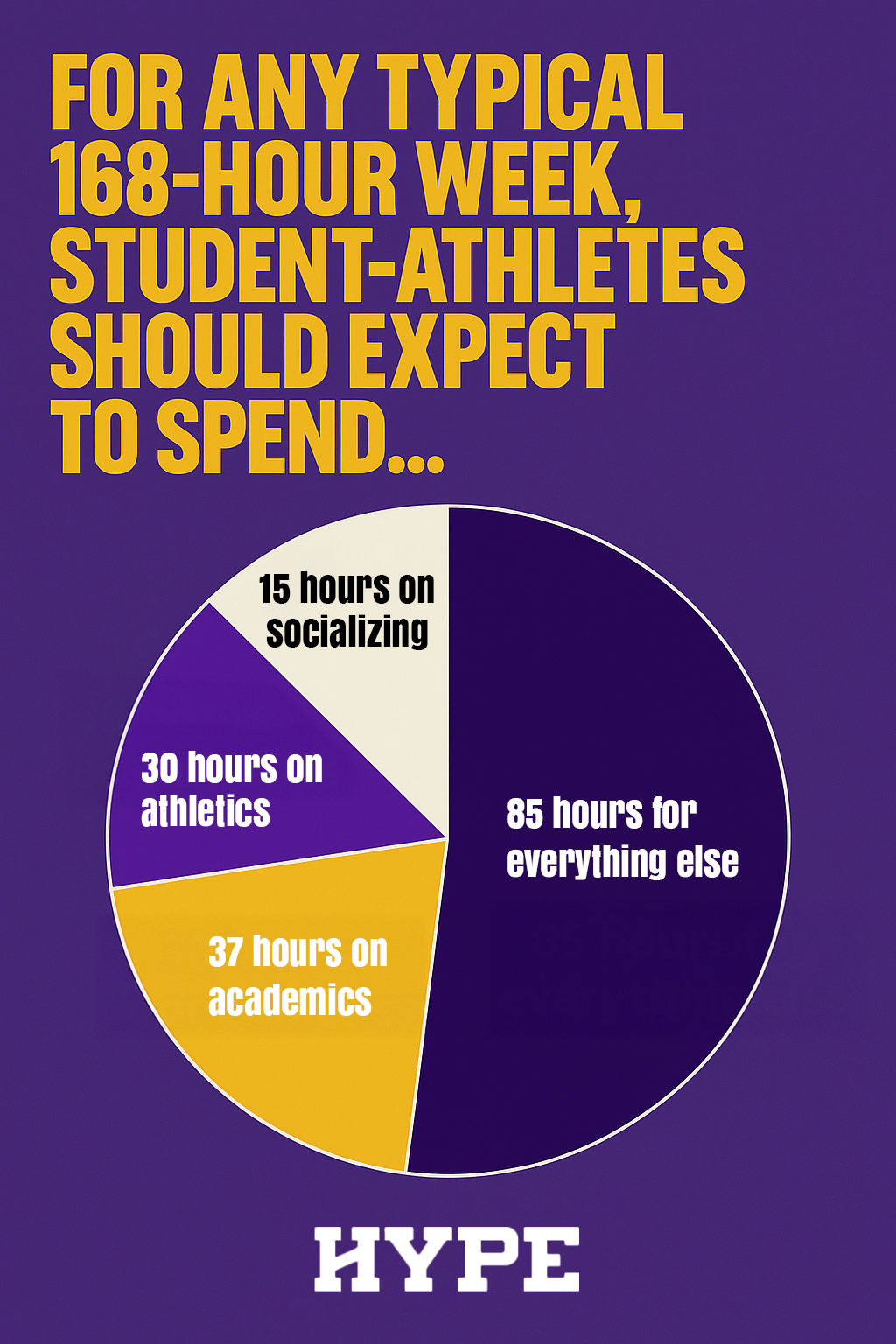
For any typical 168-hour week, student athletes should expect to spend…
- Roughly 30 hours (18%) on athletics
- Roughly 37 hours (22%) on academics
- Roughly 15 hours (9%) on socializing
- Roughly 85 hours (51%) on everything else (sleep, work, etc.)
WHAT DO ATHLETES WISH THEY'D KNOWN EARLIER ABOUT RECRUITING?
Whether it’s a career-ending diagnosis or a humbling walk-on offer, the recruiting journey rarely unfolds the way athletes expect. Cooper Manning, whose football future was cut short by spinal stenosis, and Allison Roberts, a former D1 volleyball player turned coach, have both seen how easily hype can cloud judgment – and how clarity often comes too late. Their advice isn’t about chasing the spotlight. It’s about building a future that holds up when the lights go out. From choosing fit over fame to embracing struggle as part of the process, they’re here to reframe what success actually looks like in the world of college sports – and what that means for recruitment.
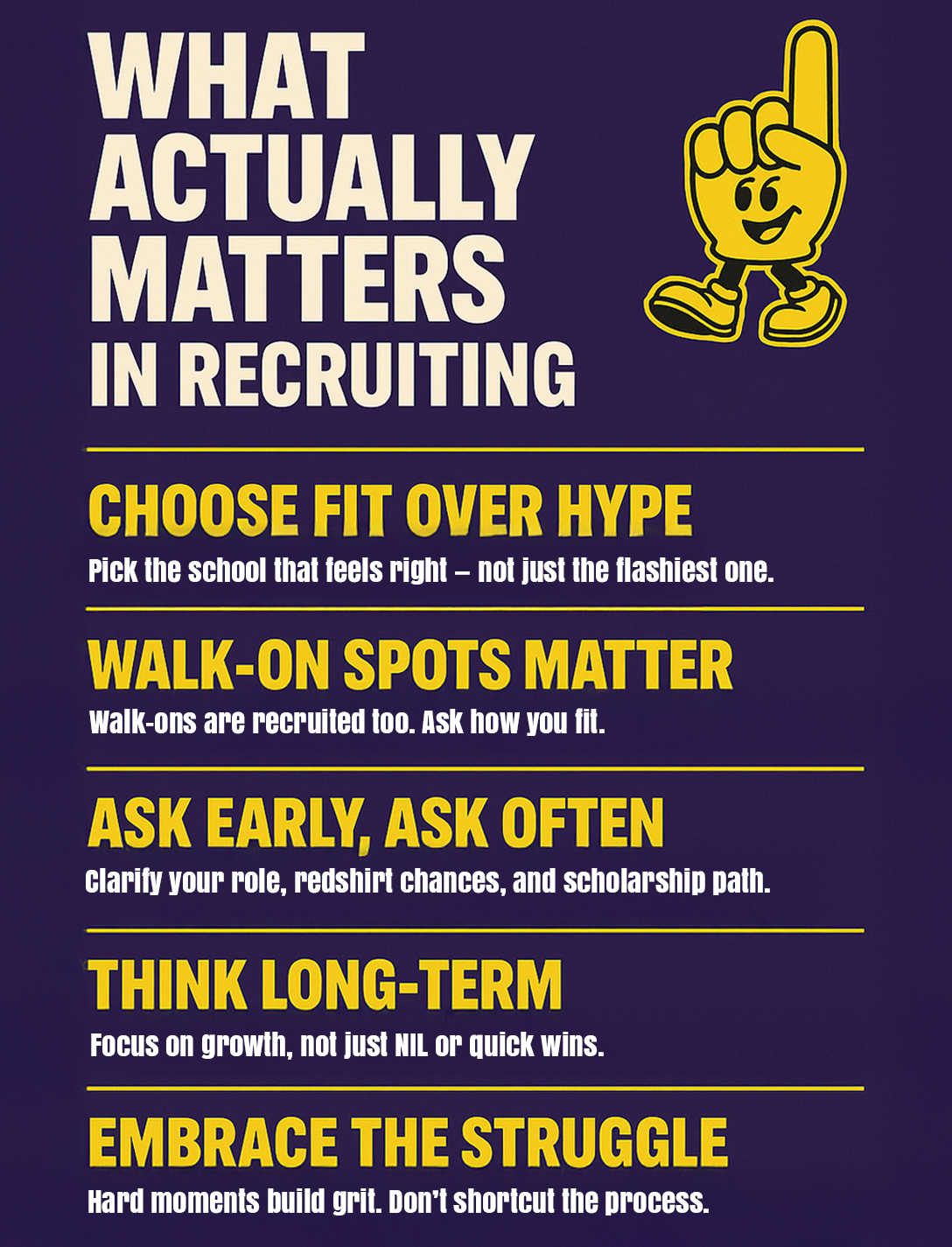
REAL TALK FROM COOPER MANNING
Cooper Manning – older brother to NFL legends Eli and Peyton – knows firsthand how fast a dream can change. His own football career ended early after being diagnosed with spinal stenosis. An article by Chron details advice he has for young athletes: pay attention, stay humble, and prepare for more than just the game. Because even when the playbook changes, your mindset doesn’t have to.
Here are 5 things to remember when considering an athletic career:
- Happiness > Hype: Don’t choose a school just for the money or spotlight – choose the place where you’ll still feel good even on your worst days.
- Play the long game: NIL deals can be tempting, but your focus should stay on growth, education, and building a strong foundation for your future.
- Let struggle shape you: Not getting immediate playing time isn’t failure – it’s an opportunity to build resilience, grit, and patience.
- Don’t chase shortcuts: Instant gratification can stall long-term growth – choose development over fast-tracking.
- Focus on the “why”: You’re not just there for football – you’re there to learn, build relationships, and grow as a person. Keep that centered.
WHAT ALLISON ROBERTS WISHES SHE'D KNOWN
In her podcast episodes, “What I Wish I Knew Pt. 1” and “What I Wish I Knew Pt. 2,” former collegiate volleyball player and coach Allison Roberts opens up about the recruitment process – what she misunderstood as a young athlete, and what came into sharper focus once she stood on the other side as a coach. Her reflections aren’t just hindsight–they’re a reality check for anyone navigating the high-stakes world of athletic recruiting. Because seeing both sides changes everything.
Here are 10 things to remember during your recruitment journey:
- Walk-on offers are valuable: Being offered a walk-on spot doesn’t mean a coach isn’t interested – walk-ons are essential and often heavily recruited.
- Scholarship ≠ validation: Not receiving a full scholarship doesn’t mean you're not valued by a program.
- Clarify your role early: Always ask coaches how they see you fitting into their program – whether that includes playing time, redshirting, or potential for future scholarship opportunities. Don’t assume – ask.
- Explore every level: Don’t fixate on playing Division I – incredible opportunities exist at D2, D3, NAIA, and JUCO programs that might be a better fit for you.
- Prioritize personal fit: Look beyond whether a school is high-profile – consider whether its size, culture, and environment actually match what you need to thrive.
- D1 doesn’t always mean “better”: Some D2 programs had better facilities and stronger teams than her D1 experience.
- Success can look different: A lower-division program might offer more playing time, recognition, and fulfillment than simply “making it” at a higher level.
- Keep an open mind: Don’t let labels or ego limit your options – some of the best opportunities come from schools you might initially overlook.
- Labels are just labels: The division doesn’t define the value of the experience – culture, coaching, academics, and opportunity matter more.
- Be open-minded: Always listen to what a school and coach have to offer before making a decision based on superficial traits.
ONLY 2% GO PRO. THAT DOESN'T MEAN YOU'RE FAILING.
Let’s get one thing straight: chasing a professional athletic career is bold. But according to the NCAA, only about 2% of student-athletes make it to the pro level. That stat isn’t meant to crush dreams – it’s meant to anchor them. If you want longevity, you need more than a Plan A. You need a pivot plan.
Here’s the truth:
- A college sports career is still one of the best launchpads you can build – even if the pro route doesn’t pan out.
- Student athletes graduate at higher rates than their peers. Why? Because the discipline, structure, and stakes of sport push you to finish strong.
- The habits you’re forming – time management, leadership, resilience – translate far beyond the field.
What comes next could be anything:
- Sports medicine, business, NIL law
- Athletic education or media communication
- Or something entirely different – rooted in the same grit you built on the court or track
But you need to start building your identity outside of sport now. Not because you’re quitting – but because a full identity is the best protection against the crash if your career path shifts.
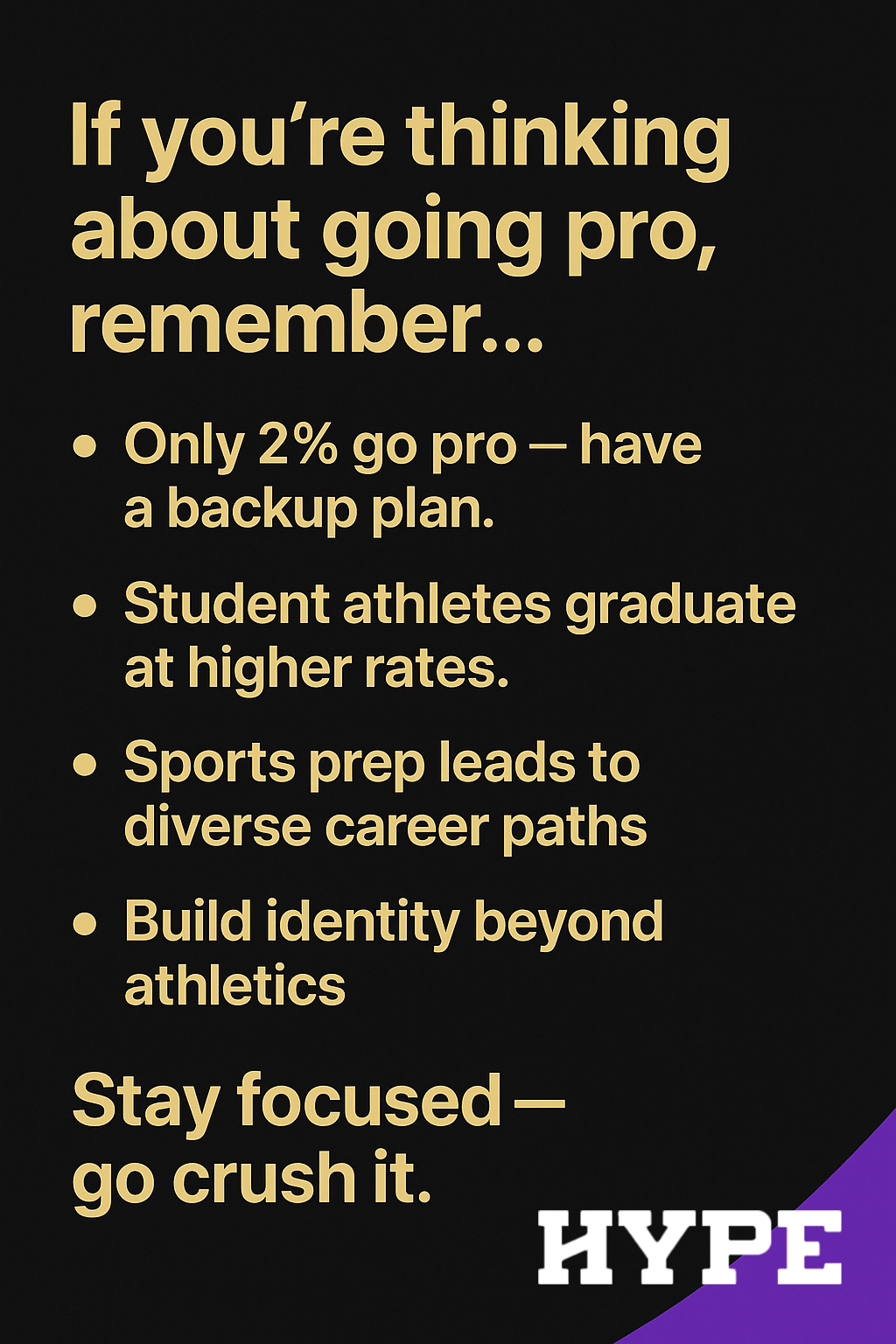
If you’re thinking about going pro, remember…
- Only 2% go pro – have a backup plan.
- Student athletes graduate at higher rates.
- Sports prep leads to diverse career paths.
- Build identity beyond athletics.
- Stay focused – go crush it!
Keep training. Stay ready. Just don’t forget to look up now and then.
You’ve got more than one shot. You’ve got a whole playbook.
